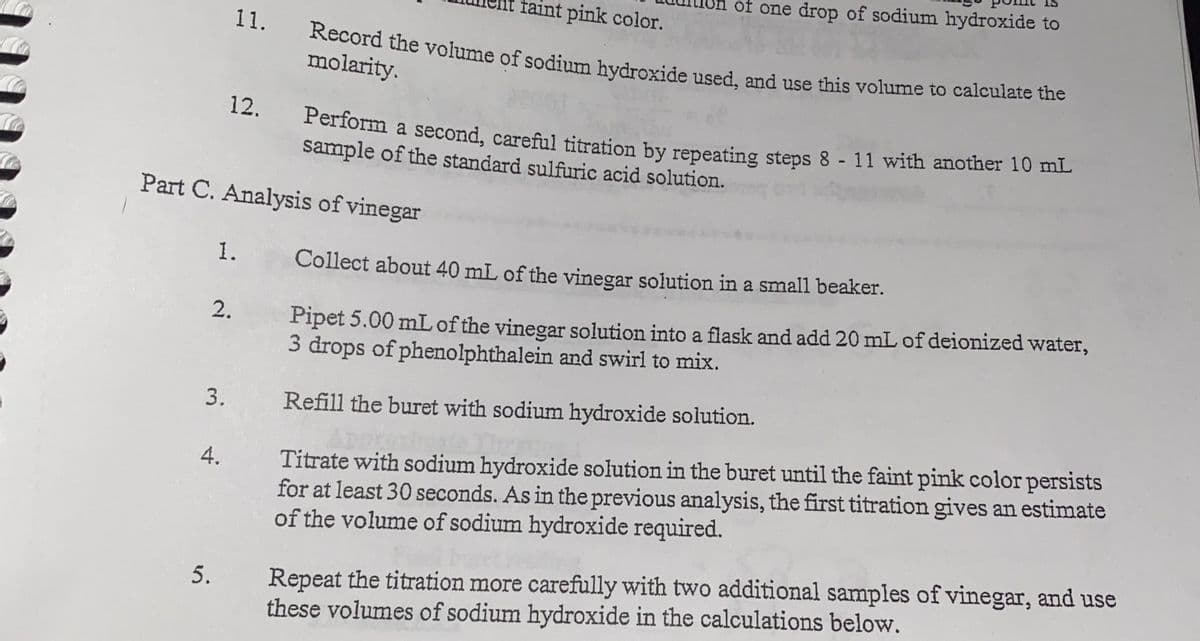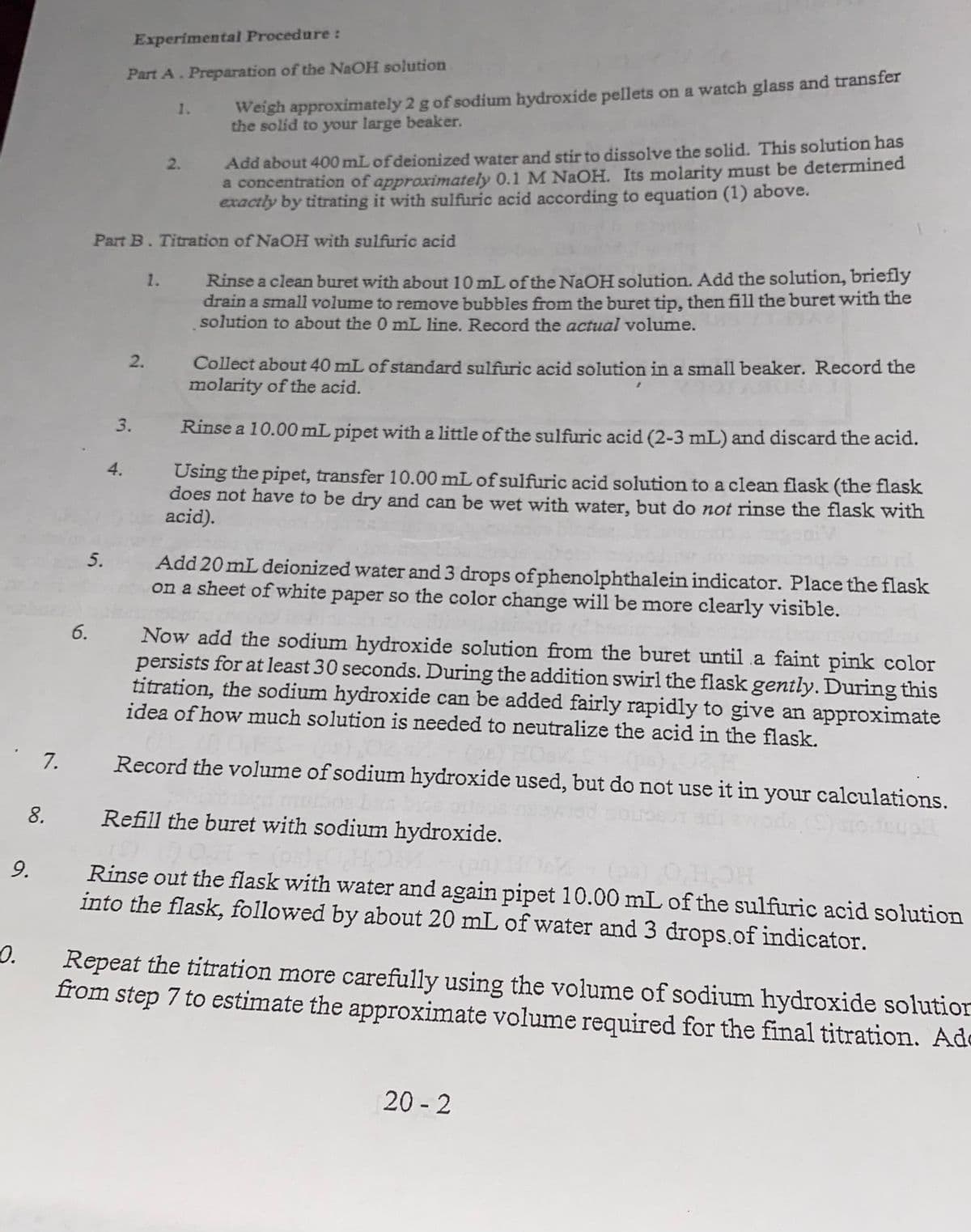Chemistry: Principles and Practice
3rd Edition
ISBN:9780534420123
Author:Daniel L. Reger, Scott R. Goode, David W. Ball, Edward Mercer
Publisher:Daniel L. Reger, Scott R. Goode, David W. Ball, Edward Mercer
Chapter16: Reactions Between Acids And Bases
Section: Chapter Questions
Problem 16.102QE
Related questions
Question
Calculate the percent difference in the two values for the molarity of the NaOH solution by:
%Difference =[M1-M2]\Mavg x100%
Given: 1st value for the molarity of NaOH = 0.0647 M
2nd value for the molarity of NaOH= 0.2627 M
NaOH vs H2SO4
Burette solution is NaOH and the pipette solution is 10.0 mL of 0.205 M H2SO4
| Titration | Initial burette reading | Final burette reading | Volume of NaOH consumed | Average volume of NaOH |
| Approximate | 0.0 mL | 31.8 mL | 31.8 mL | 31.7 mL |
| Titration 1 | 0.0 mL | 31.5 mL | 31.5 mL | |
| Titration 2 | 0.0 mL | 31.7 mL | 31.7 mL |
To find the average volume
Average volume = 31.8 mL + 31.5 mL + 31.7 mL331.8 mL + 31.5 mL + 31.7 mL3
= 31.7 mL
NaOH vs CH3COOH
Burette solution is NaOH and the pipette solution is 5.0 mL of Vinegar
| Titration | Initial burette reading | Final burette reading | Volume of NaOH consumed | Average volume of NaOH |
| Approximate | 0.0 mL | 20.1 mL | 20.1 mL | 20.3 mL |
| Titration 1 | 0.0 mL | 20.9 mL | 20.9 mL | |
| Titration 2 | 0.0 mL | 20.0 mL | 20.0 mL |
To find the average volume
Average volume = 20.1 mL + 20.9 mL + 20.0 mL320.1 mL + 20.9 mL + 20.0 mL3
= 20.3 mL

Transcribed Image Text:of one drop of sodium hydroxide to
faint pink color.
11.
Record the volume of sodium hydroxide used, and use this volume to calculate the
molarity.
12.
Feriorm a second, careful titration by repeating steps 8 - 11 with another 10 mL
sample of the standard sulfuric acid solution.
Part C. Analysis of vinegar
1.
Collect about 40 mL of the vinegar solution in a small beaker.
Pipet 5.00 mL of the vinegar solution into a flask and add 20 mL of deionized water,
3 drops of phenolphthalein and swirl to mix.
2.
3.
Refill the buret with sodium hydroxide solution.
Titrate with sodium hydroxide solution in the buret until the faint pink color persists
for at least 30 seconds. As in the previous analysis, the first titration gives an estimate
of the volume of sodium hydroxide required.
4.
Repeat the titration more carefully with two additional samples of vinegar, and use
these volumes of sodium hydroxide in the calculations below.
5.

Transcribed Image Text:Experimental Procedure:
Part A. Preparation of the NAOH solution
Weigh approximately 2 g of sodium hydroxide pellets on a watch glass and transfer
the solid to your large beaker.
1.
Add about 400 mL of deionized water and stir to dissolve the solid. This solution has
a concentration of approximately 0.1 M NAOH. Its molarity must be determined
exactly by titrating it with sulfuric acid according to equation (1) above.
2.
Part B. Titration of NaOH with sulfuric acid
1. Rinse a clean buret with about 10 mL of the NaOH solution. Add the solution, briefly
drain a small volume to remove bubbles from the buret tip, then fill the buret with the
solution to about the 0 mL line. Record the actual volume.
2.
Collect about 40 mL of standard sulfuric acid solution in a small beaker. Record the
molarity of the acid.
3.
Rinse a 10.00 mL pipet with a little of the sulfuric acid (2-3 mL) and discard the acid.
4.
Using the pipet, transfer 10.00 mL of sulfuric acid solution to a clean flask (the flask
does not have to be dry and can be wet with water, but do not rinse the flask with
acid).
5.
Add 20 mL deionized water and 3 drops ofphenolphthalein indicator. Place the flask
on a sheet of white paper so the color change will be more clearly visible.
6.
Now add the sodium hydroxide solution from the buret until a faint pink color
persists for at least 30 seconds. During the addition swirl the flask gently. During this
titration, the sodium hydroxide can be added fairly rapidly to give an approximate
idea of how much solution is needed to neutralize the acid in the flask.
7.
Record the volume of sodium hydroxide used, but do not use it in your calculations.
8.
Refill the buret with sodium hydroxide.
9.
Rinse out the flask with water and again pipet 10.00 mL of the sulfuric acid solution
into the flask, followed by about 20 mL of water and 3 drops.of indicator.
0.
Repeat the titration more carefully using the volume of sodium hydroxide solution
from step 7 to estimate the approximate volume required for the final titration. Ade
20 - 2
Expert Solution
This question has been solved!
Explore an expertly crafted, step-by-step solution for a thorough understanding of key concepts.
This is a popular solution!
Trending now
This is a popular solution!
Step by step
Solved in 4 steps

Knowledge Booster
Learn more about
Need a deep-dive on the concept behind this application? Look no further. Learn more about this topic, chemistry and related others by exploring similar questions and additional content below.Recommended textbooks for you

Chemistry: Principles and Practice
Chemistry
ISBN:
9780534420123
Author:
Daniel L. Reger, Scott R. Goode, David W. Ball, Edward Mercer
Publisher:
Cengage Learning

General Chemistry - Standalone book (MindTap Cour…
Chemistry
ISBN:
9781305580343
Author:
Steven D. Gammon, Ebbing, Darrell Ebbing, Steven D., Darrell; Gammon, Darrell Ebbing; Steven D. Gammon, Darrell D.; Gammon, Ebbing; Steven D. Gammon; Darrell
Publisher:
Cengage Learning


Chemistry: Principles and Practice
Chemistry
ISBN:
9780534420123
Author:
Daniel L. Reger, Scott R. Goode, David W. Ball, Edward Mercer
Publisher:
Cengage Learning

General Chemistry - Standalone book (MindTap Cour…
Chemistry
ISBN:
9781305580343
Author:
Steven D. Gammon, Ebbing, Darrell Ebbing, Steven D., Darrell; Gammon, Darrell Ebbing; Steven D. Gammon, Darrell D.; Gammon, Ebbing; Steven D. Gammon; Darrell
Publisher:
Cengage Learning



Principles of Modern Chemistry
Chemistry
ISBN:
9781305079113
Author:
David W. Oxtoby, H. Pat Gillis, Laurie J. Butler
Publisher:
Cengage Learning

Chemistry: Matter and Change
Chemistry
ISBN:
9780078746376
Author:
Dinah Zike, Laurel Dingrando, Nicholas Hainen, Cheryl Wistrom
Publisher:
Glencoe/McGraw-Hill School Pub Co